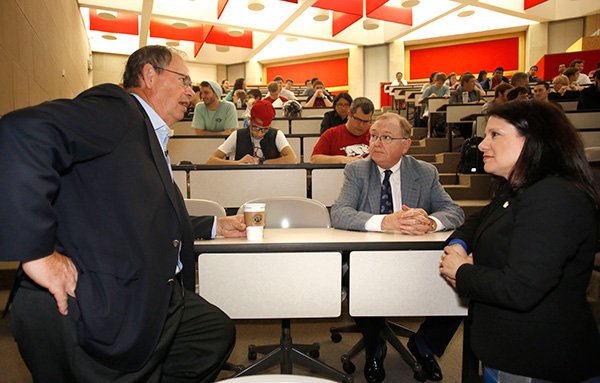Near the end of a classroom talk outlining Boeing’s customer-oriented approach to building jet planes, someone asked the company’s former CEO, Philip Condit, about the missing Malaysia Air Flight 370.
Condit, too, has been wrapped up in the mystery and closely monitoring the news.
“Every morning I get up and I go look at it,” Condit said in a Wednesday talk to about 120 University of Arkansas at Fayetteville faculty members and students.His niece Nicole Maso is a sophomore studying industrial engineering at UA, and Condit spoke during a class on manufacturing design.
The missing plane is a Boeing 777-200 model. But Condit, who resigned from Boeing in 2003 and is retired, said he knows only “the same amount that everybody else does.”
Generally, airplane accidents improve safety for future fliers, he said.
“Every time there’s an accident, you fix the problem. You do something to fix it,” Condit said.
He offered one interpretation of the circumstances surrounding the Malaysia Air jet, which disappeared in the early morning of March 8 and is presumed to have crashed inthe Indian Ocean.
“If you said to me, I want to take an airline and make it disappear, there’s several things I would do,” Condit said, going on to describe the timing of a disappearance - in the earliest morning hours, when fewer people are paying attention, and right after an air traffic “hand-off.”
“Air traffic control says, ‘You’re now leaving our control, call the next guy.’ It is your responsibility to do it right after hand-off,” said Condit, who earned a pilot’s license at 18. The Malaysia Air plane disappeared right after a handoff, he said, and he noted how its automatic reporting systemwas “clearly disabled” - if not necessarily turned off.
“All of those things happened. Does that say absolutely that there was somebody on board doing those things? No, but the probability is pretty darn high,” Condit said.
He spoke mostly about his time at Boeing, which he led during the push to create the 777 family of airplanes. Other manufacturers in the late 1980s and early 1990s werecompeting to capture the same long-range market for planes capable of flying vast distances nonstop, such as from the United States across the Pacific Ocean to Tokyo and beyond.
“A lot of times, you start by looking at your competition and try to figure out what can I do that’s different than my competition, and that’s not the important question,” Condit said. “The important question is what do your customers and your customers’ customers want out of the product, before you go ask the question of what is my competitor doing.”
The company spoke with potential buyers who at times were critical of early design ideas, Condit said. Airlines were formally invited to provide feedback on designing the “triple seven,” as it’s known. A deal with United Airlines eventually resulted in a green light to build the planes.
This phase involved bolstering teamwork within Boeing, an ideal embodied in the project’s mission statement: “People working together to produce the preferred airplane family,” Condit said. About 1,200 777s have since been delivered, with the competitors’ models for the same type of flights no longer in production.
Condit described how one customer requested a way to avoid the “big bang” heard by passengers during flights.
“We invented a hydraulically damped toilet seat,” Condit said, explaining that the “big bang” was caused by an upright toilet seat slamming down during in-flight turbulence. “That was a triple seven invention in response to a customer request.”
In an interview after the talk, Condit said he expected changes in the way flights are monitored in response to the missing Malaysia Air flight.
“My guess is, one, we will decide that we want a very, very reliable way of knowing where every airplane is, and the technology is there to be able to do it,” he said. “It will involve satellite communication, because you’re going to be over ocean.”
Passengers may not notice many changes, however.
“Most often changes aren’t visible, but they will be incorporated and things will get safer,” Condit said.
Northwest Arkansas, Pages 7 on 04/03/2014

